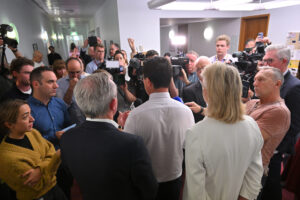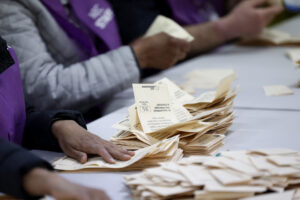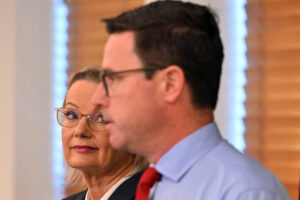Here is one truth about this election: the Liberal Party is risking its future on a prime minister who likely doesn’t have one. After years of neglect, it should come as no surprise that many Liberal voters would be looking for an alternative. What is a surprise is that the Liberal Party machine, as distinct from the prime minister’s office, would risk seats such as Kooyong, Goldstein, North Sydney and Wentworth in order to save a prime minister who is behind in all of the published polls.
How did it come to pass that Josh Frydenberg, the Liberal’s heir apparent, is in danger of losing Robert Menzies’ former seat to an independent who just six months ago was working as a doctor at the Royal Children’s Hospital? As is often the case in recent history, the answer goes back to Tony Abbott.
Abbott came to power raging against a market-based mechanism to combat climate change, against the Rudd government’s stimulus spending during the global financial crisis, and against same-sex marriage. All that is left of his “legacy” is the Liberals’ ongoing hostility to climate action and their surrender to the hard right of the National Party.
For decades the Nationals have parlayed their 4 per cent of the primary vote into disproportionate helpings of political power and pork-barrel projects for their electorates. But while the Liberals have always been happy to use public money to buy the support of their country partners, since Tony Abbott began to sound more like Barnaby Joyce than Malcolm Fraser, the Liberals have been in trouble in their blue-ribbon seats.
To understand why so many independents are doing so well in once safe Liberal seats you have to first understand why the Liberals are being so contemptuous of their former voters. And to understand that you need to understand the pressures the National Party is under, so let’s start there.
The big structural threat to the Nationals is Australia’s rising population, the mobility of that population, and the rapid emergence of rival conservative parties chasing the support of “traditional Aussie voters”.
When Menzies formed the Liberal Party about half of Australia’s population lived in capital cities. Today, it is 68 per cent. The Australian Bureau of Statistics projects that by 2050 it will be more than 75 per cent. Of the 10 million people who will move to Australia in the next 28 years, 8.5 million of them are expected to live in our major cities. That’s bad news for the Nationals. It’s bad news for the Coalition, whose electoral strategy is based around some key assumptions about how the bush works.
Scott Morrison still believes you can off end the “elites” in city seats, who once voted conservative, because the losses there will be off set by dependable votes in the regions. Those votes are dependable largely because they can be bought: promise a dam or a road or an equestrian centre and the seat is yours. Those politics don’t work in the city because facilities are taken for granted. The Coalition’s big problem is it hasn’t developed policies to appeal to those city seats – and its cargo cult campaigning in the country is under threat from shifting demographics and associated redistributions. Basically, the fewer country seats there are the less chance the Coalition has of forming government. A few election cycles from now, it will be almost impossible for the Coalition to win based on its current approach.
It also works the other way. While population growth will eat away at the Nationals’ relevance in the coming decades, population mobility is already taking its toll. Population growth and high housing prices are pushing a stream of knowledge workers and retirees into so-called sea-change and treechange destinations that once voted reliably National. Those fl eeing the cities aren’t just taking the proceeds of their house sale with them but their political values as well.
At the same time as demography is putting the squeeze on the number of safe National seats, the party’s MPs have to compete for this shrinking patch with a growing number of rivals, including One Nation, the Shooters, Fishers and Farmers, Clive Palmer’s United Australia Party and the Liberal Democrats.
It was no accident that in the middle of this election campaign Matt Canavan declared net zero was “dead”. It was a desperate attempt to hold onto the far-right voters the Nationals now chase, who are flirting with other minor parties. It also brings us back to the Liberal Party’s woes in their former heartland.
For nine years the Liberal and National parties, along with the conservative media, have worked hard to suggest that issues such as climate change, corruption, same-sex marriage and gender equity were “identity politics” designed to distract voters from the serious work of regulating the unions, cutting taxes and harming the environment.
While the Liberal and National parties are united by the strategy of blaming unions, environmentalists and high taxes for all that ails Australia, issues such as climate change, same-sex marriage and gender equity have them at each other’s throats. Sweeping these issues under the rug is about maintaining the appearance of party unity, not managing the economy.
But rather than confront the hard issues that led to the moderates tearing down Abbott and the conservatives tearing down Turnbull, Scott Morrison simply avoids them. In promising everything to everyone, Morrison delivers nothing to anyone, but hopes he can buy enough time, and enough votes, to stay in the top job for one more miraculous term. Who needs a fight over a nation-building agenda when you can build car parks and cook curries instead?
At the 2019 election, Morrison shovelled just enough money into the seats he needed to win. His daggy dad schtick took the heat off the problems he couldn’t fi x while the dozens of tiny projects he announced made him look as though he was really listening. It was a masterclass in political bait and switch, but a close look at the results makes clear the one group that didn’t fall for it was Liberal voters in safe Liberal seats. Abbott lost Warringah with a 9 per cent swing. Wentworth suff ered the second-biggest swing of 7.9 per cent. Josh Frydenberg lost 6 per cent in Kooyong. In Higgins there was another 6 per cent swing, then 4.9 per cent in Goldstein and 4.4 per cent in North Sydney. All saw votes go to Labor, even though those electorates had the most to lose from Bill Shorten’s proposed changes to capital gains tax and franking credit refunds.
Like a dog returning to its vomit, Morrison is campaigning in this election to be mayor of Australia. He is dodging responsibility for big national issues while pouring billions of our public dollars into his target seats. But not only do voters seem to have grown tired of his evasion, Liberal voters seem particularly unimpressed by a prime minister who thinks spending public money is the only answer to his political problems.
The Nationals haven’t just dragged the Liberals away from the policy issues of concern to inner-city voters, they have dragged Scott Morrison to a campaign style that places government spending and government intervention at the centre of everything he announces. Even his clumsy attempt to politicise the issue of trans athletes blew up in his face, in large part because genuine Liberals couldn’t understand why the Commonwealth government would want to push itself into the rules of sporting bodies.
While the Nationals believe their voters are impressed when a big dam or new road is secured for their electorate, do Tim Wilson or Josh Frydenberg really think new netball courts and commuter car parks are the big challenges their voters want solved? Do they want to elect a federal MP to do the work of a local council? Do Trent Zimmerman and Dave Sharma really think voters believe the jobs of the future or the solution to cost-of-living pressures come from building dams or preelection cash handouts?
For 80 years treasurers of all persuasions have been knocking back boondoggles such as the $5.4 billion Hells Gate dam in north Queensland. But in the absence of any cost–benefi t analysis to support the project, Frydenberg was the fi rst to fund it. No wonder Barnaby Joyce responded this week to the suggestion that the Liberals treated the Nats like a doormat by saying “We’re the most expensive doormat you’ll ever have.”
Using $20 billion to buy Joyce’s tepid support for a net-zero target might have got Scott Morrison through the Glasgow climate talks but it’s placed the Liberal Party in far more trouble in their once safest seats.
Abbott’s destruction of the carbon price, the Liberal Party’s destruction of the Turnbull prime ministership and Morrison’s embrace of pork-barrel politics have all cut deeply into the Liberal Party’s base. While the 2019 election was miraculous in one sense, the unexpected victory concealed just how many inner-city Liberal voters were already bleeding away.
Regardless of what happens in two weeks’ time, the days where the Liberals can assume that the wealthiest electorates in the country are theirs by birthright are over. Just ask Josh Frydenberg.
Between the Lines Newsletter
The biggest stories and the best analysis from the team at the Australia Institute, delivered to your inbox every fortnight.
You might also like
Hearing voices: why the Nats should be watching their backs
The community independent movement did not begin in Sydney or Melbourne, but in the bush.
Now that there are no safe seats – the ‘bellwether seat’ is no more.
Media analysis shows that the decade from 2007 was the bellwether era, but that era has now passed
Gender parity closer after federal election but “sufficiently assertive” Liberal women are still outnumbered two to one
Now that the dust has settled on the 2025 federal election, what does it mean for the representation of women in Australian parliaments? In short, there has been a significant improvement at the national level. When we last wrote on this topic, the Australian Senate was majority female but only 40% of House of Representatives



